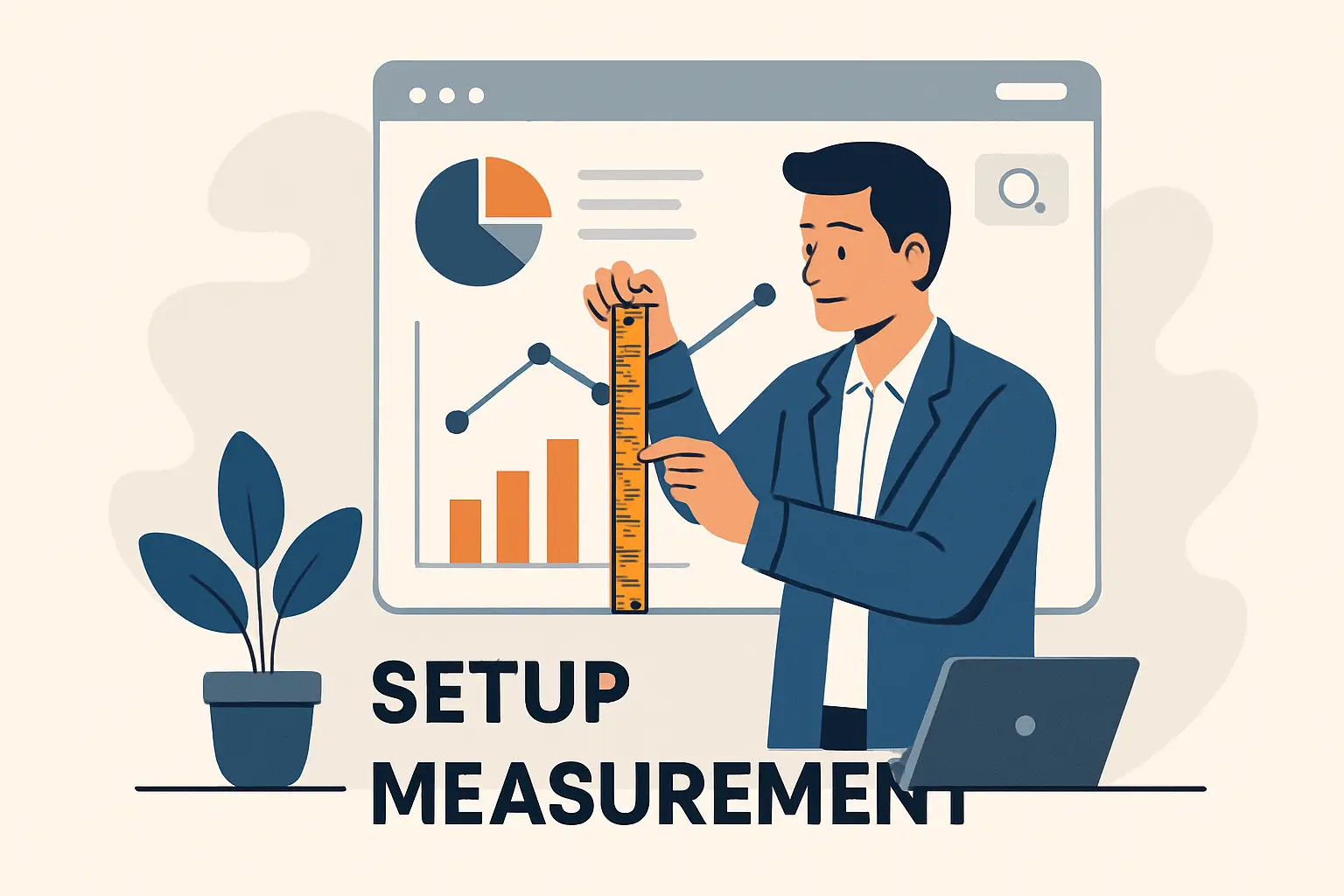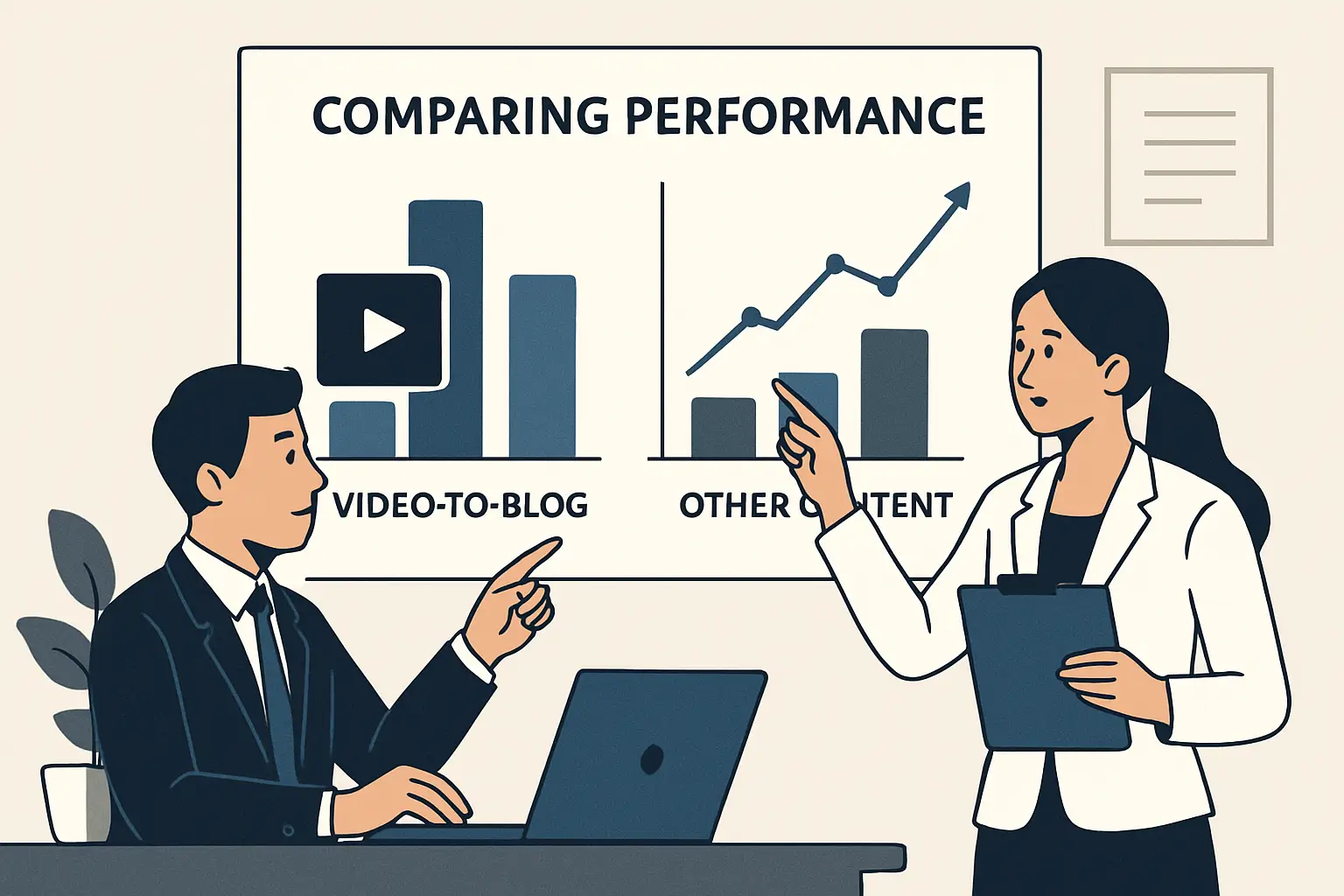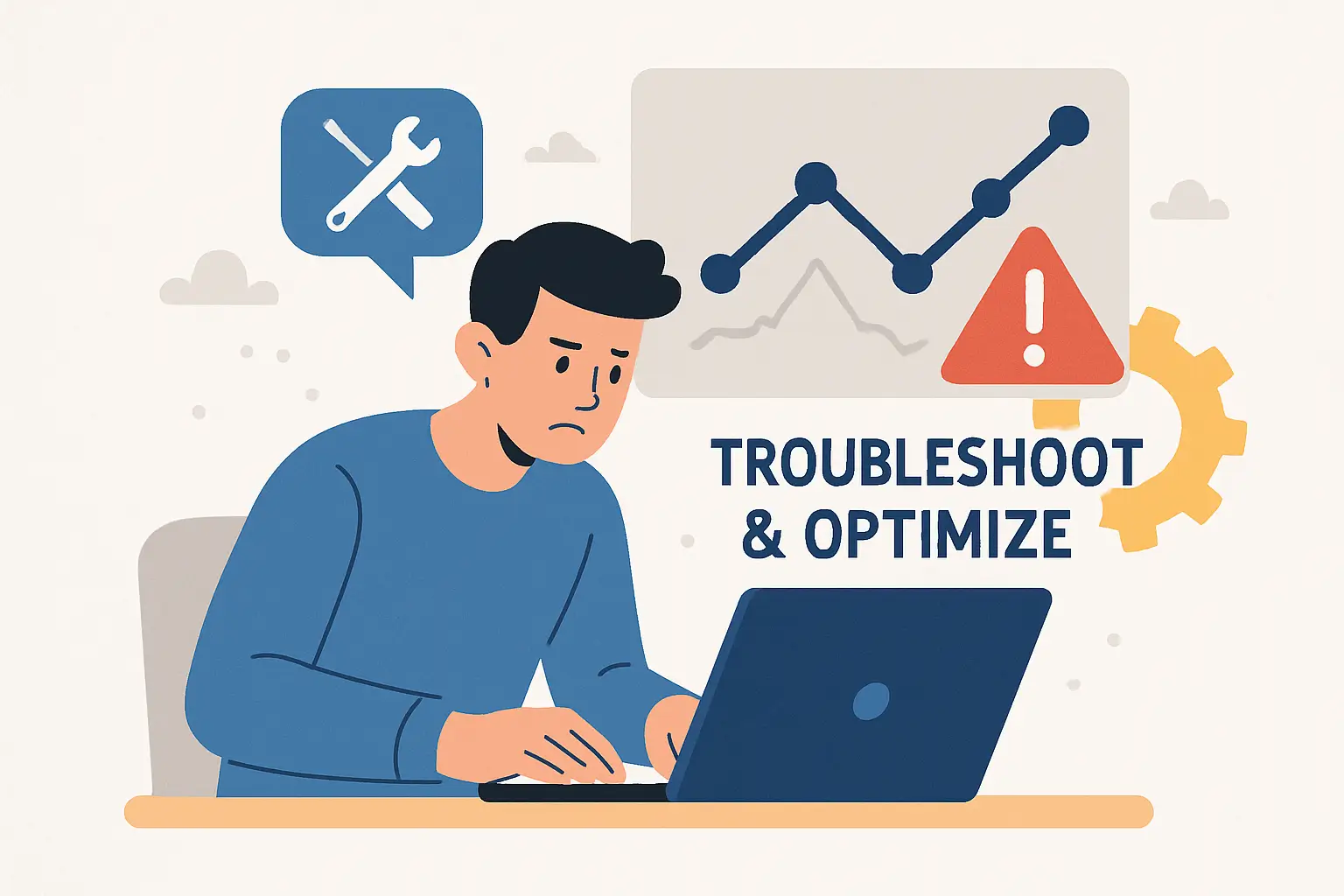How to Measure the SEO Impact of Your Video-to-Blog Posts

TL;DR — Converting videos into blog posts significantly boosts SEO because search engines rely on text to understand content, allowing your videos to be indexed more effectively. To measure this impact, track key metrics such as organic traffic, keyword rankings, click-through rates, engagement signals like bounce rate and session duration, and backlinks. Using tools like Google Analytics and Search Console helps you monitor these metrics regularly, compare performance against other content types, and identify areas for optimization. Consistent analysis and adjustments ensure your video-to-blog strategy enhances your search visibility and user engagement over time.
Table of Contents
Understanding the SEO Value of Video-to-Blog Content
If you’re turning your videos into blog posts, you’re already on the right track for boosting your SEO. But why exactly does this strategy work so well? Let’s break it down in simple terms. For a full overview, check out the ultimate guide to converting videos into SEO-optimized blog posts.
Why Turning Videos into Blog Posts Helps SEO
Search engines like Google can’t “watch” videos the way people do. They rely mostly on text to understand what your content is about. When you convert your video into a blog post—whether by transcribing, summarizing, or expanding on the topic—you’re giving search engines something they can crawl and index easily.
Think of it like this: your video is a great story, but the blog post is the written script that search engines can read. This script is packed with keywords and relevant info that helps your site show up in search results. Plus, blog posts let you add meta descriptions, internal links, and other SEO-friendly elements that videos alone can’t provide.
Tip: You can turn your videos into blog posts in one click with this Video to Blog Post Generator for free and fully SEO-optimized.
Setting Up for Measurement: What to Track

When you’re turning videos into blog posts, it’s crucial to know exactly what to track so you can see if your efforts are paying off. Think of it like tuning a car—you want to keep an eye on the right gauges to make sure everything’s running smoothly. Here’s a straightforward list of the key SEO metrics you should monitor:
Key SEO Metrics to Monitor
-
Organic Traffic Volume
How many visitors are landing on your video-to-blog posts from search engines? This tells you if your content is getting found. -
Keyword Rankings
Are your targeted keywords climbing the search results? Tracking this helps you see if your SEO strategy is working. -
Click-Through Rate (CTR)
This shows the percentage of people who see your post in search results and actually click through. A higher CTR means your title and snippet are compelling. -
Bounce Rate & Average Session Duration
These metrics reveal how engaged visitors are. A low bounce rate and longer session duration mean people find your content valuable. -
Pages per Session
Are visitors exploring more of your site after reading your post? This indicates your content is encouraging deeper engagement. -
Conversion Rates
If you have goals like newsletter signups or purchases, track how many visitors from these posts convert. -
Backlinks Acquired
Links from other sites boost your authority and SEO. Keep an eye on how many backlinks your posts earn.
How to Set Up Tracking in Google Analytics and Search Console
Getting these metrics isn’t as complicated as it sounds. Here’s how to set it up:
Google Analytics
- Make sure your site is connected to Google Analytics.
- Use segments or filters to isolate traffic to your video-to-blog posts (for example, filter by URL path).
- Monitor organic traffic, bounce rate, session duration, pages per session, and conversions for these pages.
Google Search Console
- Verify your site in Search Console if you haven’t already.
- Use the Performance report to track impressions, clicks, CTR, and average position for keywords linked to your video-to-blog posts.
- Filter by page URL to focus on these specific posts.
Pro tip: Set a regular schedule—weekly or monthly—to review these reports. Consistent tracking helps you spot trends and adjust your strategy before small issues become big problems.
By focusing on these metrics and setting up your tools properly, you’ll have a clear picture of how your video-to-blog posts are impacting your SEO. It’s like having a dashboard that tells you exactly what’s working and what needs tweaking.
Analyzing Traffic and Rankings

To figure out if your video-to-blog posts are actually pulling in more organic traffic, you’ll want to dive into Google Analytics and Google Search Console. Think of these tools as your SEO dashboard—they show you exactly how visitors find and interact with your content.
Tracking Organic Traffic in Google Analytics
If you’re wondering how to see if video blog posts rank, this is the place to start. Start by heading to Acquisition > All Traffic > Channels, then click on Organic Search. This view shows all the visitors who found your site through search engines. Next, go to Behavior > Site Content > All Pages and filter the report to include only your video-to-blog post URLs or URL patterns. This way, you’re zeroing in on the traffic those specific posts are bringing in.
Compare the organic traffic numbers before and after you published your video-to-blog posts. If you see a steady increase, that’s a good sign your content is gaining traction.
Using Google Search Console for Deeper Insights
This tool provides core SEO analytics for video content you can't afford to miss. Google Search Console complements Analytics by showing how your pages perform in search results. In the Performance report, filter by your video-to-blog post URLs. Look for rising impressions and clicks—these indicate your posts are showing up more often and enticing users to visit.
Pro tip: If you notice impressions are up but clicks aren’t, it might mean your titles or meta descriptions need tweaking to be more compelling.
Tools to Track Keyword Rankings
Knowing your traffic is great, but tracking how your posts rank for target keywords is just as important. Here are some tools that can help:
|
Tool |
Key Features |
Best For |
|---|---|---|
|
Detailed keyword tracking, competitive analysis |
Marketers wanting all-in-one SEO |
|
|
Keyword rank tracking, content insights |
Content-focused SEO pros |
|
|
Keyword rankings, page optimization |
Beginners and intermediates |
|
|
Free, shows average position and clicks |
Budget-conscious users |
|
|
User-friendly rank tracking |
Small businesses and solopreneurs |
|
|
Desktop software, keyword monitoring |
Users preferring offline tools |
Pick a tool that fits your budget and comfort level. Regularly checking your rankings helps you see if your video-to-blog posts are climbing the search results ladder or if you need to adjust your SEO strategy.
By combining traffic data with keyword ranking insights, you’ll get a clear picture of how your video-to-blog posts are impacting your SEO—and where to focus your efforts next.
Evaluating Engagement and User Behavior

When you repurpose your videos into blog posts, the big question is: are people actually sticking around to engage with your content? To figure this out, you’ll want to focus on a few key metrics that reveal how visitors behave once they land on your page.
Key Metrics to Track Visitor Engagement
Here’s a quick rundown of the most telling signals:
- Average Session Duration: This tells you how long visitors stay on your page. Longer sessions usually mean your content is holding their attention.
- Bounce Rate: This is the percentage of visitors who leave after viewing just one page. A lower bounce rate suggests people are interested enough to explore more.
- Pages per Session: If users are clicking through to other pages, it’s a good sign they find your site valuable.
- Scroll Depth: This shows how far down the page visitors scroll. If they’re reaching the bottom, they’re likely consuming your full post.
- Engagement Events: Set up event tracking in Google Analytics to monitor actions like video plays, link clicks, or downloads.
- Heatmaps and Session Recordings: Tools like Hotjar or Crazy Egg let you see exactly where users click and how they move through your page, giving you a more visual sense of engagement.
What Shows Your Video-to-Blog Posts Are Working?
If your repurposed content is doing its job, you’ll notice these positive signals:
- Longer Average Session Duration: Visitors spend more time on your pages.
- Lower Bounce Rates: Fewer people leave immediately after arriving.
- More Pages per Session: Users explore other parts of your site.
- Active Engagement: More video plays, clicks, or comments.
- Repeat Visitors: People come back again, showing ongoing interest.
Pro Tip: If you're not seeing results, revisit your content strategy to better measure the SEO impact of your video to blog post.
By keeping an eye on these metrics, you’ll get a solid sense of whether your video-to-blog strategy is truly engaging your audience — and helping your SEO at the same time.
Comparing Performance: Video-to-Blog vs. Other Content

When you're trying to figure out if your video-to-blog posts are really boosting your SEO, the key is to compare them side-by-side with your regular blog posts. Think of it like a friendly competition between two players on your team—you want to see who’s scoring more goals.
How to Compare SEO Impact
Start by segmenting your analytics data based on content type. Use Google Analytics to filter pages by URL patterns or tags that clearly separate your video-to-blog posts from your standard blogs. Then, look at these key metrics for each group:
- Organic traffic: Are more people finding your video-to-blog posts through search engines?
- Keyword rankings: Are your video-to-blog posts climbing higher for your target keywords?
- Bounce rate: Are visitors sticking around longer on video-to-blog posts compared to regular ones?
- Session duration: How much time are users spending on each type of content?
- Conversion rates: Are video-to-blog posts driving more sign-ups, purchases, or other goals?
- Backlinks and social shares: Do video-to-blog posts attract more external links or shares on social media?
By lining up these numbers, you get a clear picture of which content type is pulling its weight.
Benchmarks to Judge Success
Knowing what to measure is half the battle. Here are some practical benchmarks to keep in mind:
|
Metric |
What to Look For |
Why It Matters |
|---|---|---|
|
Organic Traffic Growth |
Steady increase over baseline or past periods |
Shows growing visibility |
|
Keyword Rankings |
Improvement or stable top positions |
Indicates better search relevance |
|
Click-Through Rate (CTR) |
2-5% or higher, depending on search position |
Reflects how compelling your snippets are |
|
Session Duration |
Above your site average |
Means visitors find your content engaging |
|
Bounce Rate |
Below your site average |
Suggests visitors are exploring more |
|
Conversion Rate |
Aligned with your business goals |
Proves content drives action |
|
Backlinks & Shares |
Increasing numbers |
Builds authority and trust |
Tip: Set realistic, time-bound goals for these benchmarks. For example, aim for a 10% increase in organic traffic to your video-to-blog posts within three months. This keeps your progress measurable and your strategy focused.
By tracking these metrics regularly, you’ll know if your video-to-blog strategy is paying off or if it’s time to tweak your approach. Remember, SEO is a marathon, not a sprint—consistent measurement helps you stay on course.
Troubleshooting and Optimizing for Better Results

If your video-to-blog posts aren’t ranking or pulling in traffic like you hoped, don’t worry — this is a common bump on the road. Think of SEO like gardening: sometimes your plants need a little extra water, sunlight, or pruning to thrive. Here’s how you can troubleshoot and optimize your posts to get better results.
What to Do When Your Posts Aren’t Ranking or Getting Traffic
Start by checking your keyword targeting. Are you aiming for keywords that your audience actually searches for? Use tools like Google Keyword Planner or Ubersuggest to find relevant, achievable keywords. Avoid overly competitive terms that might bury your posts.
Next, look at your on-page SEO:
- Make sure your titles and meta descriptions clearly include your target keywords.
- Use headers (H1, H2, H3) to organize content and signal relevance to search engines.
- Add internal links to related blog posts or pages on your site to boost authority.
Content quality matters a lot. Is your post comprehensive and engaging? Try to answer your audience’s questions fully and make the content easy to read with short paragraphs, bullet points, and visuals.
Don’t forget to promote your posts! Share them on social media, include them in your email newsletters, and reach out to other bloggers or websites for backlinks.
Also, check for technical SEO issues like slow page speed or crawl errors using tools like Google Search Console or PageSpeed Insights. These can silently kill your rankings.
Finally, keep your content fresh by updating it regularly. SEO isn’t a set-it-and-forget-it game.
If you’re still stuck, consider consulting an SEO professional who can dig deeper into your site’s data.
How to Improve SEO Performance Over Time
SEO is a marathon, not a sprint. To keep improving:
- Update your posts regularly with new info and optimize for emerging keywords.
- Use analytics and search console data to spot what’s working and where visitors drop off.
- Improve user experience by speeding up your pages, making them mobile-friendly, and ensuring readability.
- Build more internal links from other relevant pages to strengthen your site’s structure.
- Encourage user engagement by inviting comments or adding interactive elements like polls or quizzes.
- Keep promoting your content to attract backlinks and social signals.
- Conduct periodic SEO audits to catch and fix any issues before they become problems.
Tip: According to a study by HubSpot, updating and republishing old blog posts with new content and images can increase organic traffic by up to 106%. So don’t hesitate to refresh your video-to-blog posts!
By following the above steps, your video to blog SEO results should greatly improve. Keep experimenting, learning, and optimizing — your efforts will pay off!
Frequently Asked Questions (FAQ)
What are the main SEO benefits of turning videos into blog posts?
Turning videos into blog posts helps SEO by providing search engines with text-based content that they can crawl and index, increasing the chances of your content appearing in search results. It also allows for better keyword optimization, meta descriptions, and internal linking, which can improve your rankings and visibility.
Which key metrics should I track to measure the SEO impact of my video-to-blog posts?
You should track organic traffic, keyword rankings, click-through rates, bounce rate, session duration, pages per session, conversion rates, and backlinks. These metrics help you understand how well your content is performing in search engines and engaging visitors.
How can I set up tracking for my video-to-blog posts in Google Analytics and Search Console?
In Google Analytics, ensure your site is connected, then filter traffic by your post URLs to monitor organic visits, bounce rate, and conversions. In Search Console, verify your site, then use the Performance report to track impressions, clicks, CTR, and average position for your posts, filtering by URL. Regularly review these reports to assess performance.
What should I do if my video-to-blog posts are not ranking well or getting traffic?
Check your keyword targeting to ensure relevance and competitiveness, optimize on-page SEO with clear titles, meta descriptions, headers, and internal links, improve content quality, promote your posts on social media, and fix technical issues like page speed. Updating and refreshing your content regularly can also boost rankings.
How can I improve the SEO performance of my video-to-blog posts over time?
Continuously update your content with new information, optimize for emerging keywords, improve user experience, build internal links, encourage engagement, promote your posts for backlinks, and conduct SEO audits. Regularly analyzing your data helps you identify what works and where to improve.
